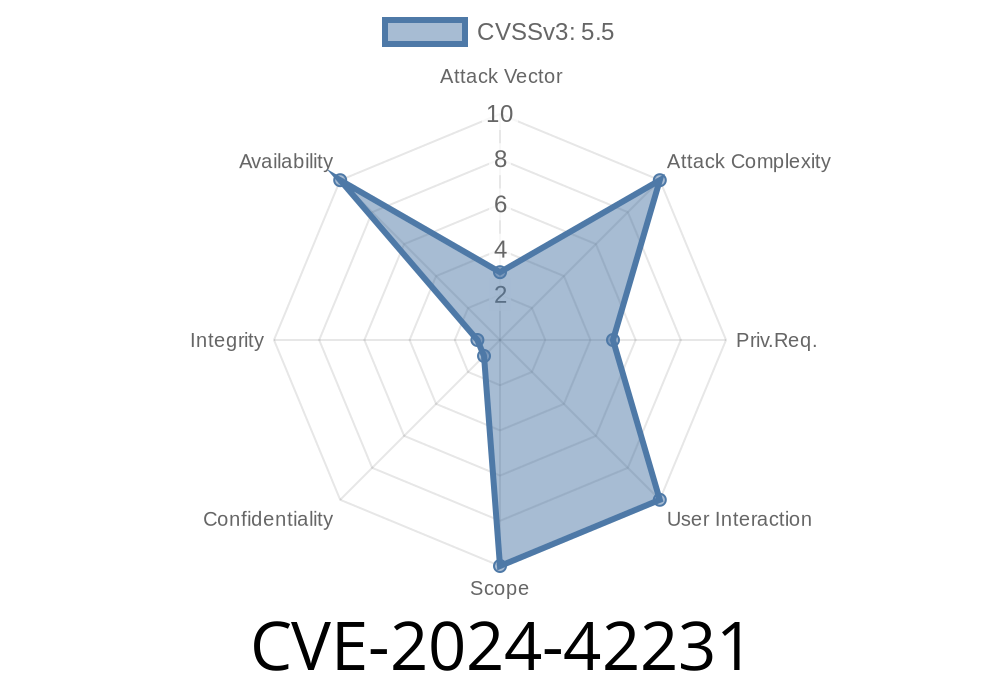Btrfs, the modern copy-on-write filesystem for Linux, is praised for its advanced features such as snapshots, checksumming, and multi-device support. However, as with any complex system, subtle bugs can slip in. Recently, a critical vulnerability has been patched related to zoned devices. This post breaks down the technical details behind CVE-2024-42231: how it works, why it matters, and a look at the code changes that fix it.
Vulnerability: Miscalculation of usable space in Btrfs on zoned storage devices
- Impact: Risk of filesystem running out of space prematurely (ENOSPC), causing unexpected application or system failures
What is Btrfs Zoned Storage?
Btrfs supports zoned block devices—hardware where data writes must be aligned to specific zones of fixed size, such as Shingled Magnetic Recording (SMR) hard drives and Zoned Namespace (ZNS) SSDs. In these setups:
The Core Function: calc_available_free_space()
This kernel function estimates how much more metadata (system/internal) space Btrfs can allocate. Its job is vital: if it gets calculations wrong, the filesystem might "think" there's more space available than there really is.
Original Buggy Logic
In zoned mode, the code tried to compute free space in a way that's partly okay for conventional drives, but assumed partial chunks within a zone could be allocated. That's simply false—zone allocations must be zone-sized and aligned.
Code Snippet (Before Fix)
// Incorrectly calculated data_chunk_size could be not zone-aligned
u64 data_chunk_size = BTRFS_STRIPE_LEN;
if (btrfs_is_zoned(fs_info))
data_chunk_size = calculate_somehow(...);
It also sometimes returned an available size that's not a multiple of the zone size.
Problems
1. Over-commits metadata allocations — The function reports more "available space" than you can actually use.
Async metadata reclaim routines "think" they need less work, so they don’t free up enough space.
4. Users/applications may get ENOSPC (No space left) even when Btrfs says there’s space left!
CVE Details and Timeline
- CVE: CVE-2024-42231
- Upstream Patch: commit
Code Snippet (Fixed)
// Now using actual zone size and aligning result at the end
if (btrfs_is_zoned(fs_info))
data_chunk_size = data_sinfo->chunk_size; // i.e., zone size
// Later in the function, after computations
if (btrfs_is_zoned(fs_info))
avail = round_down(avail, zone_size); // align output
return avail;
Reference:
- btrfs: zoned: fix calc_available_free_space() for zoned mode
Fill up the device with normal data, leaving only a little space.
3. Start allocating lots of metadata (e.g., lots of snapshots or small files in deep directories).
Btrfs calculates available metadata space using the buggy logic.
4. The system thinks enough space is left to accept user requests, but when it tries to allocate, the device refuses since zones aren’t (fully) available.
Applications and users get unexpected ENOSPC errors.
In a worst-case scenario, critical system processes might fail (log journaling, package upgrades, etc.) and the filesystem could even enter a readonly mode.
Example "Exploit Code" (User Side)
# Simulate near-full state
dd if=/dev/zero of=/mnt/btrfs/bigfile bs=1M count=<almost fills device>
# Heavy metadata operation
for i in {1..100000}; do mkdir /mnt/btrfs/manydirs/dir$i; done
This loop can trigger the condition: Btrfs reports enough space, but zone-aligned allocations suddenly fail.
Impact & Who Should Care
- Users of zoned block devices (especially with large zones): You are at direct risk! (E.g., cloud storage backends, enterprise arrays, archival HDDs)
General users on conventional drives: You're unaffected.
- System integrators: If you run mission-critical Btrfs on ZNS/SMR, patch NOW to avoid downtime.
What To Do
- Upgrade your kernel to a release with this patch merged
Further Reading
- NVD CVE-2024-42231 page
- Btrfs wiki: Zoned block devices
- Kernel patch mailing thread
- Btrfs documentation
Summary
CVE-2024-42231 reveals how subtle miscalculations can cripple storage on modern hardware. If you use Btrfs with zoned block devices, updating your Linux kernel is critical to avoid mysterious "no space left on device" errors. The patch aligns internal logic with hardware limitations, letting async reclaim work as it’s supposed to and keeping your data safe.
If you're curious to test or want more code examples for your environment, let me know in the comments! Stay safe and keep your filesystems healthy.
Timeline
Published on: 07/30/2024 08:15:08 UTC
Last modified on: 07/30/2024 19:30:52 UTC
